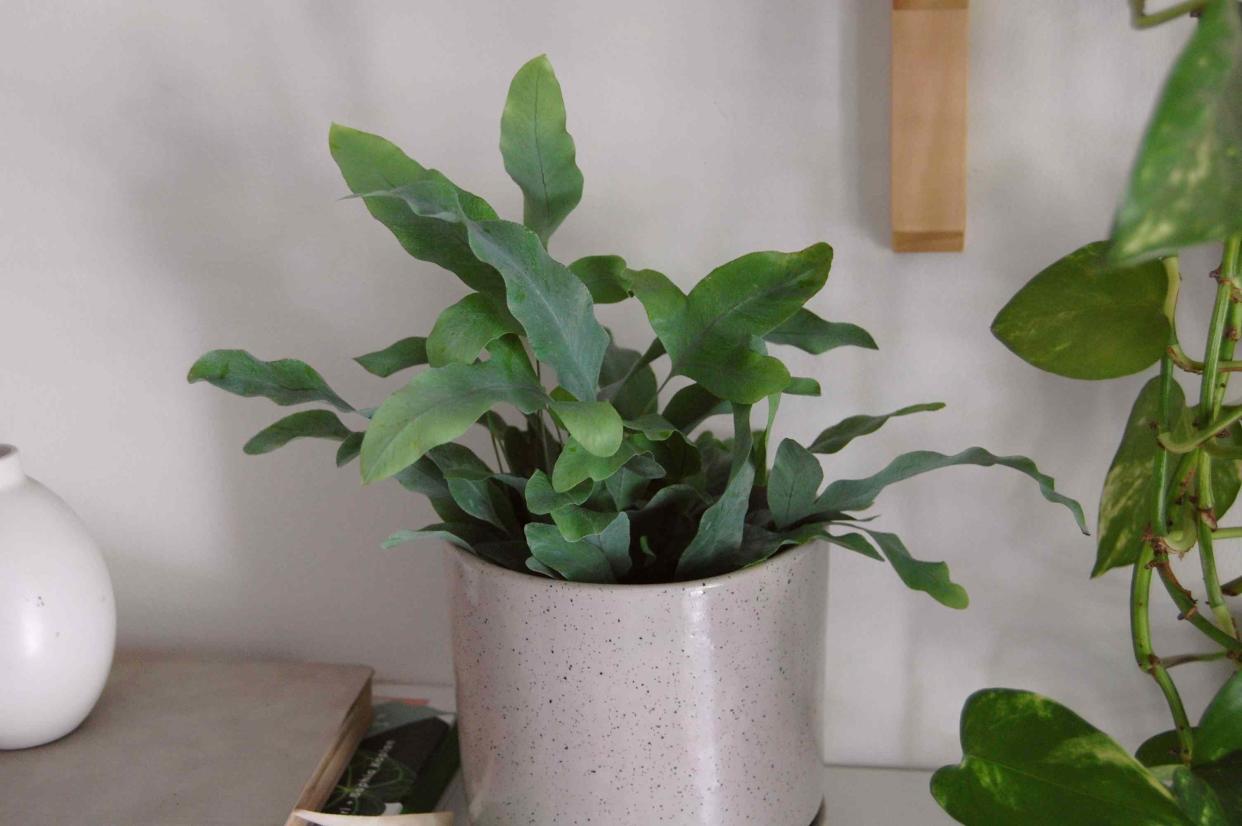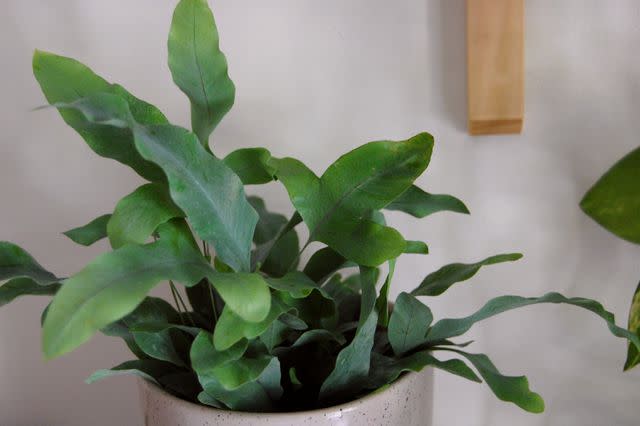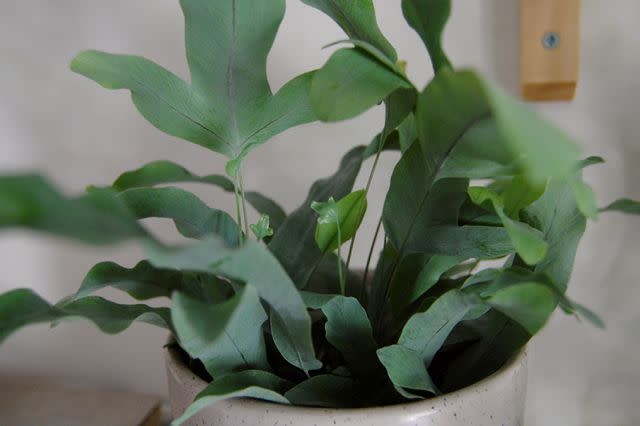How to Grow and Care for Blue Star Fern

The Spruce / Cori Sears
Blue star fern, also called golden polypody and cabbage palm fern, is known for its elongated, multi-lobed fronds and pleasant blue-green color. While most fern species need high humidity, blue star fern gets by with standard household levels of moisture in the air, making it an ideal houseplant fern. This popular option also prefers medium indoor light and moist but well-draining soil.
Common Name | Blue star fern, golden polypody, cabbage palm fern |
Botanical Name | Phlebodium aureum |
Family | Polypodiaceae |
Plant Type | Perennial |
Mature Size | 2-4 ft. tall, 3-6 ft. wide |
Sun Exposure | Partial, shade |
Soil Type | Moist but well-drained |
Soil pH | Acidic |
Hardiness Zones | 8-13 (USDA) |
Native Area | North America, South America |
Blue Star Fern Care
Blue star fern is a fairly easy-going houseplant and a good choice for fern beginners. Here are the main care requirements for growing a blue star fern:
Choose a spot that receives medium-to-bright, indirect light.
Plant blue star fern in a chunky, well-draining potting mix.
Keep it evenly moist, but be cautious of overwatering.
Choose a warm location with average to high humidity.
Fertilize lightly during spring and summer.

The Spruce / Cori Sears

The Spruce / Cori Sears
Light
While many ferns thrive in low light conditions, the blue star fern appreciates plenty of medium to bright indirect light. It can still survive in low light conditions, but its foliage will be sparser and less lush. Avoid prolonged periods of intense direct sunlight, which can burn this plant’s delicate leaves.
Soil
Since blue star ferns are naturally epiphytic, they do best in a loose, airy potting mix. A soilless mix such as orchid bark mix is perfect. If you do use soil, be sure to add plenty of perlite and orchid bark to make the mix super chunky and airy.
Water
Like most ferns, the blue star fern appreciates consistent moisture. However, the way you water your fern will depend on the type of soil mix you have it potted in.
If you are using orchid bark, you should water your plant using a soak-and-dry method. This is done by filling a bowl (or your sink) with room temperature water and placing the pot directly in the water, ensuring the roots are submerged. Let the plant sit in the water for 15 to 20 minutes so the orchid bark can absorb the water.
In order for the soak-and-dry method to work, the plant needs to be potted in a pot with drainage holes so the water can drain freely from the pot when it’s removed. Water your fern once or twice a week during spring and summer, and cut back in fall and winter.
Alternatively, if you are using a mix with soil (which holds water a bit more easily), it’s best to water when the top inch of soil has dried out. The soil should be consistently moist, but not waterlogged. Be careful not to overwater your blue star fern as these plants are sensitive to root rot.
Temperature and Humidity
This fern appreciates warm temperatures and average to high humidity. Standard household temperature and humidity levels are usually fine, but it certainly won’t protest if it’s given a little extra humidity.
Naturally humid rooms in the home such as bathrooms and laundry rooms are great spots to grow a blue star fern, or you can increase humidity using a small humidifier near the plant. Avoid placing your fern close to drafty vents and windows which will dry out the air. Keep temperatures between 57 to 81 degrees Fahrenheit (14 to 27 degrees Celsius).
Fertilizer
The blue star fern is not considered a high feeder but appreciates regular fertilization during the spring and summer months. Apply a balanced houseplant fertilizer diluted to half strength once a month during watering. Stop fertilizing in fall as soon as temperatures start to drop.
Pruning
Blue star fern can occasionally benefit from pruning, especially if it has a lot of leggy growth or browning fronds, but pruning is not necessary. If you wish to prune blue star fern, do so in early spring, and use clean, sharp scissors. Do not prune during the fern's dormancy in winter.
Propagating Blue Star Fern
Blue star ferns are most easily propagated by division, although mature plants can also be reproduced by spores. Propagation is a great way to create new plants, or thin out a large plant. To propagate your blue star fern by division, follow these simple steps:
Remove your blue star fern from its pot and lay it sideways to examine the root ball.
Using your hands, gently tease apart the roots until you can separate a clump of fronds from the main plant. Be careful to break as few roots as you can in the process.
If necessary, use a sharp, clean knife or pair of pruning shears to cut away any roots that are holding the plants together and preventing division.
Pot the newly divided plant in a separate container using a well-draining potting mix and water thoroughly.
Return both plants to their original locations and keep the soil evenly moist.
Potting and Repotting Blue Star Fern
The blue star fern does not need to be repotted often—every two to three years once it’s outgrown its pot is all it needs. Choose a new pot that is only two to four inches larger than the last container, and refresh as much of the soil as you can during repotting. If possible, wait until spring or summer to repot since the plant is actively growing in these months.
Common Pests & Plant Diseases
Like most houseplants, the blue star fern is susceptible to a few common pests and diseases. Look for pests like spider mites, thrips, fungus gnats, and diseases like crown rot and root rot. Avoid crown rot by ensuring you never pour water on the fronds of the plant during watering, and provide plenty of drainage in the soil to prevent root rot.
Common Problems With Blue Star Fern
Ferns are known for being tricky to grow as houseplants due to their preference for humid conditions and frequent watering. While the blue star fern is known for being relatively hardy and easy to grow, it is still susceptible to a few common problems.
Browning Fronds
Fronds that are turning brown and crispy are usually a sign that your fern needs higher humidity or is suffering from underwatering. Unfortunately, there’s no way to save a frond that has already turned brown and crispy, but by adjusting the fern’s growing conditions you can prevent future fronds from dying off.
Curling Fronds
Another common symptom of underwatering and a lack of humidity is fronds curling in on themselves. Try adding a small humidifier to your plant’s growing environment, or placing the pot on a pebble tray filled with water to increase humidity.
Frequently Asked Questions
What are the brown spots on the back of my blue star fern’s leaves?
If you notice small, symmetrical brown dots on the back of your fern’s fronds don’t panic. Your fern is growing spores in an attempt to reproduce, which is a sign it is healthy and well-established.
Can blue star ferns be mounted on wood like staghorn ferns?
Since blue star ferns are epiphytes just like staghorn ferns, they can also be mounted on wood or similar material and grown vertically with success. Follow the same method for mounting staghorn ferns to mount and display your blue star fern.
Should I mist my blue star fern daily?
When possible, it is always best to use a humidifier or pebble tray to increase humidity around a plant versus misting. Misting will not increase humidity long term, and leaving moisture on the fern’s fronds can present opportunities for fungal infections to spread.
Read Next: 4 Basic Tips for Making Your Ferns Thrive Indoors
Read the original article on The Spruce.

